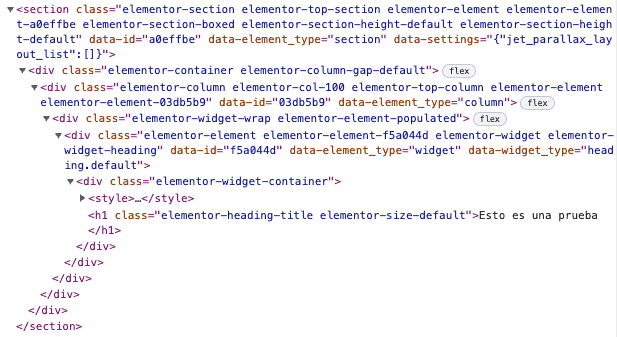Introduction of DOM (Document Object Model) and its correlation with SEO
The Document Object Model (DOM) is a crucial aspect of web development that can significantly impact a site’s SEO performance. DOM is a representation of a web page’s content hierarchy and structure, which web browsers use as a blueprint to render the HTML elements. In addition to directly affecting the user interface (UI) and user experience (UX), the depth of the DOM structure can indirectly impact a site’s SEO by influencing the site’s loading speed, readability, and crawlability for search engine bots. Therefore, it is pivotal for web developers and SEO professionals to possess an in-depth understanding of the DOM and its relationship with SEO to ensure optimal website performance.

Explanation of the role of page builders
Page builders play an essential role in simplifying web development and design, especially for individuals with limited technical backgrounds. These powerful tools enable users to create visually appealing and fully functional websites with minimal coding effort by utilizing predefined layouts, templates, and drag-and-drop features. While advantageous in terms of user-friendliness and efficiency, page builders can inadvertently introduce complexity into a site’s DOM structure, potentially jeopardizing its SEO performance. Consequently, it is crucial for businesses employing page builders to be mindful of the potential risks and implement best practices to mitigate the adverse effects on DOM depth and overall SEO success.
In-depth explanation of what DOM is
The Document Object Model (DOM) is a programming interface for HTML and XML documents. It represents a document’s structure akin to a tree, where each node like element, attribute, and text is an object that a browser can interact with.
How DOM works with web browsers
Web browsers leverage DOM to parse web content. After downloading a webpage, the browser builds the DOM by parsing the HTML document into a hierarchical node tree structure. JavaScript interacts with this tree-like structure to manipulate web content and achieve dynamic changes in response to user actions and network events.
Role of DOM in loading website elements
The DOM plays a critical role in loading website elements. The visual rendering of a web page doesn’t start until the DOM is processed. Improper handling of DOM could lead to inefficient website load performance, potentially diminishing user experience and negatively impacting SEO.

Understanding DOM depth
DOM depth is an important concept relating to the number of nested layers or nodes in the DOM tree. A linear or shallow DOM tree tends to perform better since browsers can parse it faster. Conversely, a deep or complex DOM tree with many cascades may lead to slower rendering and performance inefficiencies.
How a deeper DOM structure can impact website load times
A deeper and denser DOM structure can increase HTML document size and reduce the rendering speed, consequently impacting website load times. Higher load times can lead to unoptimized user experience and potentially increase bounce rates.
How website performance is linked to SEO
Web performance is a key determinant of SEO. Search engines like Google consider website speed and responsiveness as part of their ranking algorithm. Poor performing websites, often due to complex and deep DOM structures, can decrease visibility on search engine result pages (SERPs), leading to reduced organic traffic, lower user engagement, and ultimately a decline in overall website ranking. Thus, maintaining an optimized DOM depth is integral to achieving high website performance and SEO.
What are page builders?
Page builders are cloud-based applications aiding in the creation of web pages, especially for those less versed in coding. They offer a user-friendly interface with ‘drag and drop’ features which allow the construction of large, complex websites with relative ease. Page builders, with their premade templates and layouts, ease the process of web development and offer an attractive alternative to traditional HTML and CSS coding.
Benefits of using page builders
Without a doubt, page builders provide an array of benefits. They eliminate the need for extensive knowledge of coding, reducing the barriers to website creation. This democratizes the web development process, enabling more individuals and businesses to establish an online presence. Furthermore, page builders speed up the process of developing pages, allowing for quicker deployment of websites. They also offer design versatility with a vast range of templates and the flexibility to customize as needed.
While page builders simplify the web design process, they do so by automating the generation of the website’s underlying code. This convenience, however, may lead to the creation of excessive and unnecessary nested layers in the DOM. Given that every feature, widget, and design element added by a page builder could potentially introduce a new level to the DOM, usage of these tools can inadvertently result in a deep and complex DOM structure.

The impact of nested layers created by page builders
An increase in nested layers or a deep DOM structure typically results in slower website speeds. This occurs as the browser requires more time to parse through the layers of the DOM to render the webpage. Slower website speed correlates directly with poor UX/UI design, increased bounce rates, and decreased website traffic, which in turn negatively affects SEO performance.
Numerous studies and experiments corroborate this relationship between page builders usage and increased DOM complexity. For instance, a speed comparison test run on WordPress websites, using various popular page builders, revealed a substantial increase in page load times. The test attributed the decreased speed to the excessively complex DOM structures, a direct offshoot of the added elements via the builder. It was evident that page builders, although convenient, introduced latency that could be detrimental to website performance metrics and eventually SEO.
The connection between website load times and SEO
Website load times are a crucial factor in search engine optimization (SEO), as search engines like Google factor in page speed when determining rankings. Faster load times offer a better user experience, consequently leading to improved search engine rankings. Deep DOM structures, often generated by page builders, can negatively affect website load times, ultimately hindering SEO performance
Numerous case studies have outlined the correlation between page builders and negative SEO effects due to increased DOM depth. Let us examine two such cases:
Case Study 1: A popular e-commerce site experienced lower organic search traffic after adopting a page builder. Their DOM depth increased significantly, causing slower load times, which in turn negatively impacted their SEO rankings. After analyzing the website’s performance, they decided to optimize the DOM tree structure leading to improvements. Consequently, their organic traffic recovered, illustrating the adverse effect of DOM depth on SEO.
Case Study 2: A blog site experienced a downturn in organic traffic after a redesign which utilized a page builder. The redesign resulted in a more complex DOM tree, causing longer load times. By hiring an SEO expert to refactor the code and reduce the DOM depth, the blog site was able to show improved website performance, and their organic traffic started growing again, underscoring the DOM depth’s role in SEO performance.
Precautions in using page builders
It is crucial to be aware of the potential SEO implications when using page builders.
Users can take the following precautions:
- Research and choose page builders that prioritize SEO optimization like the Yoast SEO plugin for WordPress.
- Routinely monitor website load times and compare them to industry standards to ensure optimal performance.
- Collaborate with SEO experts or web developers to analyze and optimize the website’s overall performance.
- Techniques to optimize DOM depth while using page builders
Minimizing the impact of deep DOM structures on SEO can be achieved through various approaches.
Keep these techniques in mind while using page builders:
- Limit the number of nested elements and widgets by keeping the website design simple and clean.
- Utilize HTML5 or CSS3 features to replace or minimize JavaScript usage for reduced browser rendering overhead.
- Apply lazy loading for images, videos, and heavy elements to speed up initial rendering.
- Leverage browser caching, content delivery networks (CDNs), and reliable hosting services to improve load times.
- Regularly audit the website’s DOM and refactor it to maintain an optimal structure.
Conclusion
In this analysis, we have closely examined the interconnected relationship between Document Object Model (DOM) depth, the use of page builders, and their collective impact on Search Engine Optimization (SEO). We’ve clarified that while page builders bring tremendous value to website creation with their user-friendly interfaces and pre-made templates, they can inadvertently contribute to deeper DOM structures.
The increased DOM depth can negatively impact website load times, an essential factor in determining SEO rankings. We’ve validated these assertions by referencing various case studies, wherein the increased DOM depth was traced back to the usage of page builders and had led to a decline in SEO performance.
Moving forward, it’s crucial to have a deeper understanding of the role of page builders and how they contribute to DOM depth. This knowledge is fundamental to future SEO practices for businesses and industries operating in the digital space. While page builders will continue to be a significant tool in website creation, they should be used with due consideration of their impact on DOM structure, and ultimately, SEO performance.
Encouragement for best practices for balancing use of page builders and maintaining SEO-friendly DOM depths.
In conclusion, while the benefits of page builders are undeniable, consideration for SEO should remain a top priority. It is not a question of choosing between convenience of design and better SEO ranks, but rather how to effectively balance the two. With diligent monitoring of website load times, careful usage of nested elements, and routine auditing of your website’s DOM structure, it is achievable to leverage the advantages of page builders while maintaining an SEO-friendly website. Keep in mind, success in any field requires continuous learning and adaptation – this maxim certainly applies to the ever-evolving world of SEO.
Frequently Asked Questions
How do page builders affect the depth of the Document Object Model (DOM)?
Page builders streamline the web creation process by automating the generation of a website’s underlying code. However, this can unintentionally lead to the creation of an intricately nested DOM structure. Each feature or widget added by a page builder can introduce a new level in the DOM, resulting in a deep DOM structure.
What is the connection between DOM depth and SEO?
A deep DOM can negatively affect a website’s loading speed, as browsers need more time to parse through several layers of the DOM to render the webpage. Load times are an essential factor in a website’s SEO performance. Therefore, through affecting load times, the depth of the DOM can potentially impact SEO.
Can the use of page builders negatively impact my site’s SEO standing?
While page builders can simplify the web design process, if not used judiciously, they can add unnecessary complexity to your website’s DOM. This could lead to slower site performance and potentially lower your site’s SEO rankings. However, by following best practices and diligently optimizing your site, it is indeed possible to leverage page builders’ benefits while maintaining strong SEO performance.
How can I mitigate the negative effects of page builders on SEO?
Here are some steps you can take:
- Regularly monitor your website’s load times, compare them to industry standards, and look for ways to improve
- Limit the number of nested elements added by the page builder to ensure you’re not unnecessarily increasing your website’s DOM depth.
- Consider collaborating with SEO experts or web developers to audit and optimize your website’s overall performance.
Are there any techniques to optimize DOM depth while using page builders?
Yes, there are several techniques you can implement to manage DOM depth whilst using page builders:
- Limit the use of heavy elements and widgets that create nested layers in the DOM.
- Implement lazy loading for images, videos, and heavy elements.
- Optimize browser caching and hosting options, and consider using content delivery networks (CDNs) for improved speed.
- Regularly perform audits to refactor the DOM and maintain an optimal an optimal structure.
Resources
Explore the following resources for a deeper understanding of page builders, DOM depth, and SEO. Each will provide additional insights and expertise to supplement what we’ve discussed in this article.
For search engine optimization basics straight from the industry-leading search engine.
MDN Web Docs – Document Object Model (DOM)
For understanding the Document Object Model’s fundamentals, this resource is valuable. It provides comprehensive information about DOM, its structure, and how it affects website performance.
Yoast SEO: the #1 WordPress SEO Plugin
For comprehensive SEO optimization tips for WordPress, as well as suggested plugins to help with optimization.
Learning How to Improve Web Performance by Reducing DOM size
For an in-depth understanding of how reducing the DOM size can significantly improve web performance.
W3C – HTML5
Please note: Always leverage these resources with a critical eye on reliability and applicability to your specific context. Constant learning and diligent application are the keys to success in the dynamic field of SEO and web development.
If you’re ready to take your online presence to the next level, sign-up for our web design and development and cloud services today!
We’re confident that our services will help you achieve your online goals and we’re excited to be a part of your business journey. Don’t wait, contact us now and start seeing results!






